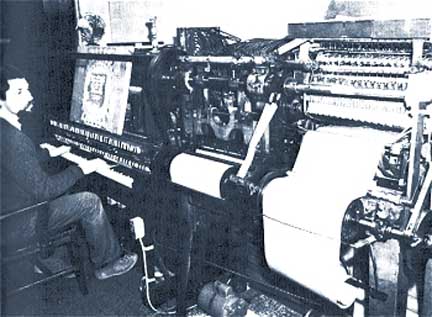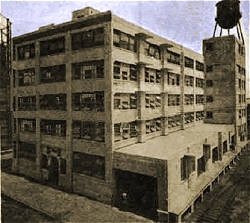QRS Music
1026 Niagara St., Buffalo, NY
Q-R-S Music Rolls Inc - Official Webpage
History Beneath Illustations
QRS Music
1026 Niagara St., Buffalo, NY
Q-R-S Music Rolls Inc - Official Webpage
History Beneath Illustations
Photos taken June 2017   Medina sandstone foundation  |
YouTube video: Piano roll production at QRS Music (online June 2017) |
QRS has been manufacturing piano rolls since 1900 and is the only manufacturer of piano rolls still in business today, with over 5,000 master recordings and 45,000 music rolls. We have rolls from actual performances by legendary greats such as Liberace, Scott Joplin, Fats Waller and George Gershwin, among others. - QRS Music (online June 2017) |
|
Q-R-S Marking Piano
1912 One of the first machines to produce master rolls for player pianos by recording actual performances
The Q-R-S marking piano was one of the first machines to produce master rolls for player pianos by recording actual performances. Other roll recording devices were developed within this time frame, but as far as known, the Q-R-S is the only example still in existence and in service. The marking piano made it possible to capture live performances--including those of Igor Stravinsky, George Gershwin, and Duke Ellington--and thus preserve keyboard artistry of many artists, incidentally documenting the history of pre-radio 20th century American popular music. The first "hand-played" roll that QRS released was Pretty Baby by ragtime pianist Charlie Straight. Player pianos provided home entertainment to millions of Americans from 1900 to 1930 and were the first widely successful consumer device to use binary encodement of data in its software, configured as piano rolls. Prior to the development of recording devices, sheet music was transcribed to master rolls by hand. This marking piano, in particular, originally saw service from 1912 to 1931, when the Depression and declining roll sales made alternate means of creating master rolls more economical. Following a player piano revival in the 1960s that increased demand for rolls, this machine was restored and refinished in 1972 (at which time the roll drive motor was replaced). Artists who have recorded on the restored machine include Liberace, Peter Nero, Ferrante & Teicher, George Shearing, Roger Williams, and Eubie Blake. - ASME (online June 2017) |
|
Q-R-S Marking Piano
In 1912, Clark invented the Q-R-S Marking Piano which made it possible to record the master roll data from live performances rather than hand punching from sheet music. Hailed as a breakthrough and used by the QRS Music Company from 1912 to 1931, it not only added a human dimension to piano rolls but also made possible the preservation of historic performances by early jazz and blues artists. The Marking Piano ushered in the heyday of the player piano, which was to last through the Roaring Twenties. Sales peaked in 1926, when over 10 million QRS rolls were sold. Retired from service in 1931, the Marking Piano was restored in 1971 and has since been used to record performances by a variety of world-class artists, including Liberace, Peter Nero, George Shearing, Eubie Blake, Marian McPartland, and Ferrante & Teicher. - The American Society of Mechanical Engineers: The Q-R-S Marking Piano (online June 2017) |
|
National Historic Mechanical Engineering Landmark The Q-R-S Marking Plano
1912 The Q-R-S Marking Piano was one of the first
machines to produce master rolls for player pianos by recording actual
performances. Invented by Melville Clark (c.1850 - 1918), it is still
in service. Each key of a modified piano is pneumatically connected to
a stylus in the recorder. As an artist plays, each stylus marks its
note on a roll of paper being pulled over a cylinder covered with
carbon paper, faithfully recording the performance. Upon completion of
the recording, the carbon marks are cut out and a production master is
made from this roll.
The American Society of Mechanical Engineers — 1992 - The American Society of Mechanical Engineers: The Q-R-S Marking Piano (online June 2017) |
 The famous QRS marking piano, responsible for most of the company's product from the mid-1920s through the 1970s, as pictured in the late 1970s. Source: Bill Edwards, Ragpiano.com (online September 2017) "
Invented by Melville Clark (ca. 1850-1918), founder of QRS and piano
player designer from Chicago, the Q-R-S recording machine is a modified
piano, with each of its 88 keys pneumatically connected to a stylus in
the recorder. These styli are suspended horizontally above a roll paper
at a point where it passes over a carbon cylinder. When a key is
depressed, the corresponding pneumatic collapses, pressing the stylus
on the moving roll paper as it passes over the carbon cylinder, which
leaves a mark on the underside. As an artist plays, each stylus marks
its note on a roll of paper being pulled over a cylinder covered with
carbon paper, faithfully recording the performance. Upon completion of
the recording, the carbon marks are cut out and a production master is
made from this roll by pneumato-electrical means." - ASME (online June 2017)
 Piano roll ... Source: Pianola.co.nz (online September 2017)  1919 Steinway Welte-Mignon Player Piano Source: Wikiwand: Player Piano (online September 2017)  Source: Faszination Pianola (online September 2017) |
|
Partial reprint NEW MODEL MUSIC ROLL CUTTING PLANT OF Q R S CO. Big Factory in the Bronx Most Modern in Every Particular, With Plenty of Daylight, Latest Machine Equipment, Direct Shipping Facilities and Other Important Features to Stimulate Production — New York Now Made the Headquarters for the Company's Recording Work Source: Bill Edwards, Ragpiano.com (online September 2017)  A view of the new QRS plant in New York City in 1920. The new modern plant of the Q R S Music Co., located at 135th street and Locust avenue, New York, is now operating under practically full capacity. It is under the personal management of Lee S. Roberts, vice-president of the Q R S Music Co., whose experience in the manufacturing of music rolls has been of long duration and whose authority on proper merchandising is generally acknowledged. ...This plant, which is of the most modern construction, is a five-story fireproof structure, with daylight pouring in on all four sides, giving the entire interior enough light so that artificial illumination is practically unnecessary in any part of the building. In order that this daylight plant will never be obstructed by nearby buildings and also in order to allow for future expansion, the Q R S people purchased the entire block, bounded by 134th street, 135th street and by Locust avenue and Walnut street. The plans of the building have been so arranged as to allow the construction of a duplicate plant on the block, whenever the demand for Q R S music rolls becomes sufficient to demand such an expansion. The new building has a floor space of approximately one hundred thousand square feet. There, is no doubt but this factory will be able to take care of and give prompt attention to the increasing demand for Q R S rolls. It is a splendid addition to the Q R S chain of factories, extending from coast to coast, the other factories being in Chicago and San Francisco. |
|
Excerpts QRS has ended production of player-piano rolls By Mark Sommer January 3, 2009 The Buffalo News (online June 2017) The remark scribbled at the end of the production sheet said simply, “End of era.” It was written shortly after the last piano roll came off the assembly line at QRS Music Technologies, 1026 Niagara St., at noon Wednesday. The halt in production comes 108 years after the company was founded in Chicago, and 42 years since it moved to Buffalo. Rolls used in player pianos reached their peak in popularity in the early 20th century, when a roll of paper was able to reproduce music through perforations signifying notes played on the piano. The company is now a leading manufacturer of digitized and computerized player-piano technology that runs on CDs. “The roll market has continued to decline, which is no surprise,” said Bob Berkman, the company’s music director and manager of the Buffalo office. “It no longer is, nor has it been for some time, the central part of our business. Until Thursday, QRS was the only continuously operating mass producer of piano rolls in the world. The only other company, in Australia, stopped earlier this decade. Sales dropped about 80 percent from 15 years ago to around 50,000 annually, Berkman estimated. Five of the 10 employees in Buffalo have been laid off because of the piano roll shutdown. The remaining employees will produce all the music for its high-tech Pianomation system for now. But that operation ultimately will be absorbed into QRS’s Seneca, Pa., plant. The piano-roll manufacturing equipment also is being sent there. However, QRS stopped making player pianos earlier this decade. The company had bought the sole manufacturer of player pianos, Classic Player Piano, in 1993 with the express purpose of providing a continuing source of pianos to play its rolls. Berkman said reassembling the piano roll factory elsewhere will be difficult. One machine dates back to the 1880s when it was used to make shoes, and for the past 100 years has made the tabs with brass eyelets used to hook the roll into a piano. |